Economics Report: Labour Market and Unemployment in Canada
VerifiedAdded on 2022/08/12
|6
|914
|22
Report
AI Summary
This economics report examines the relationship between the unemployment rate and overall labor market performance in Canada, focusing on the accuracy of the unemployment rate as a key indicator. The report explores various labor market indicators such as population, labor force, participation rate, employment, and unemployment. It analyzes trends from 1976 to 2016, highlighting the diverging patterns between unemployment and employment rates, particularly after 2008. The study attributes the decline in labor force participation to Canada's aging population and discusses the limitations of the unemployment rate in providing a comprehensive view of labor market health. The report recommends considering labor market participation based on age as a more reflective indicator and concludes that while the unemployment rate is a widely used metric, it does not provide a specific reason for the unemployment. The report references several academic sources to support its analysis.
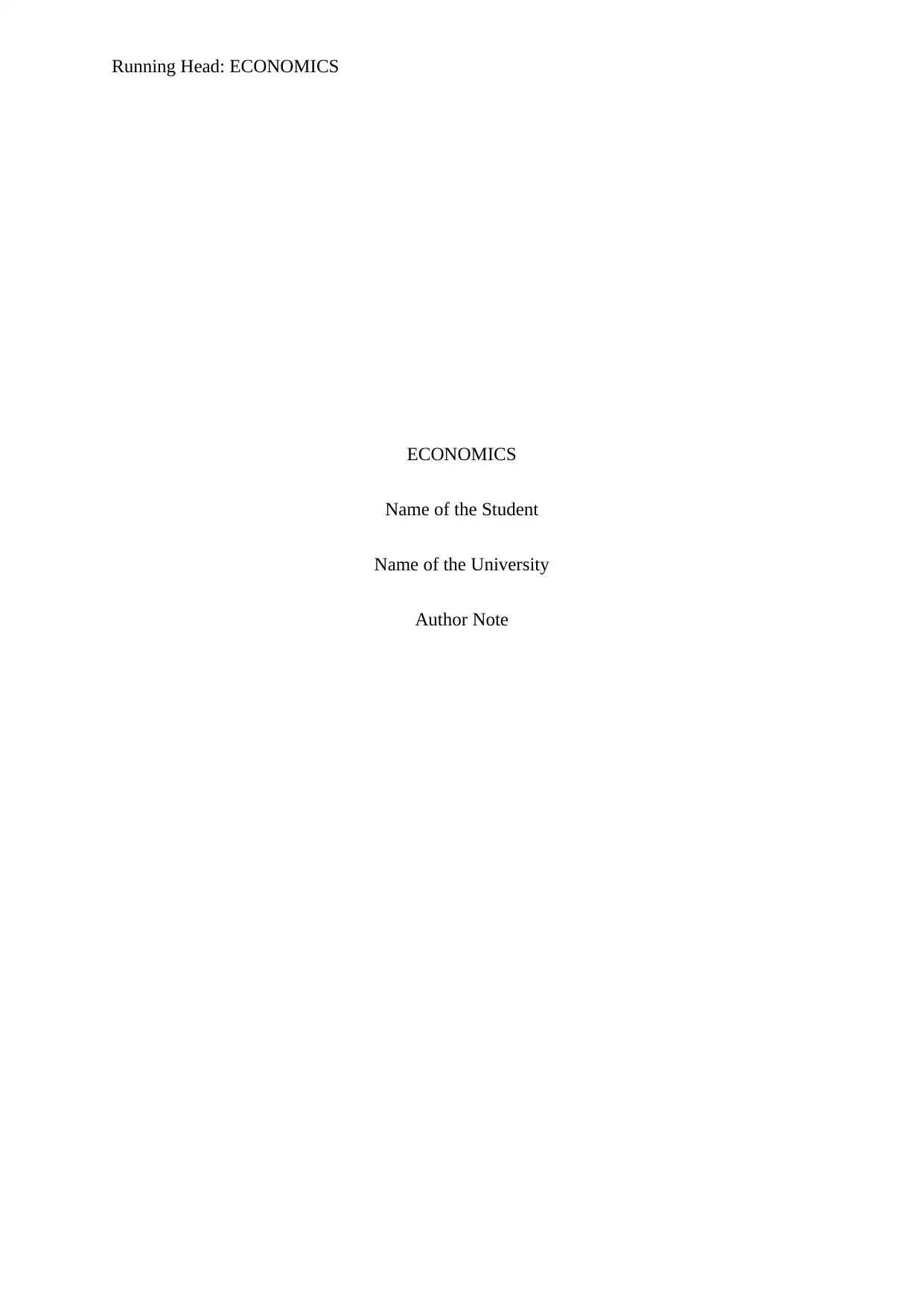
Running Head: ECONOMICS
ECONOMICS
Name of the Student
Name of the University
Author Note
ECONOMICS
Name of the Student
Name of the University
Author Note
Paraphrase This Document
Need a fresh take? Get an instant paraphrase of this document with our AI Paraphraser
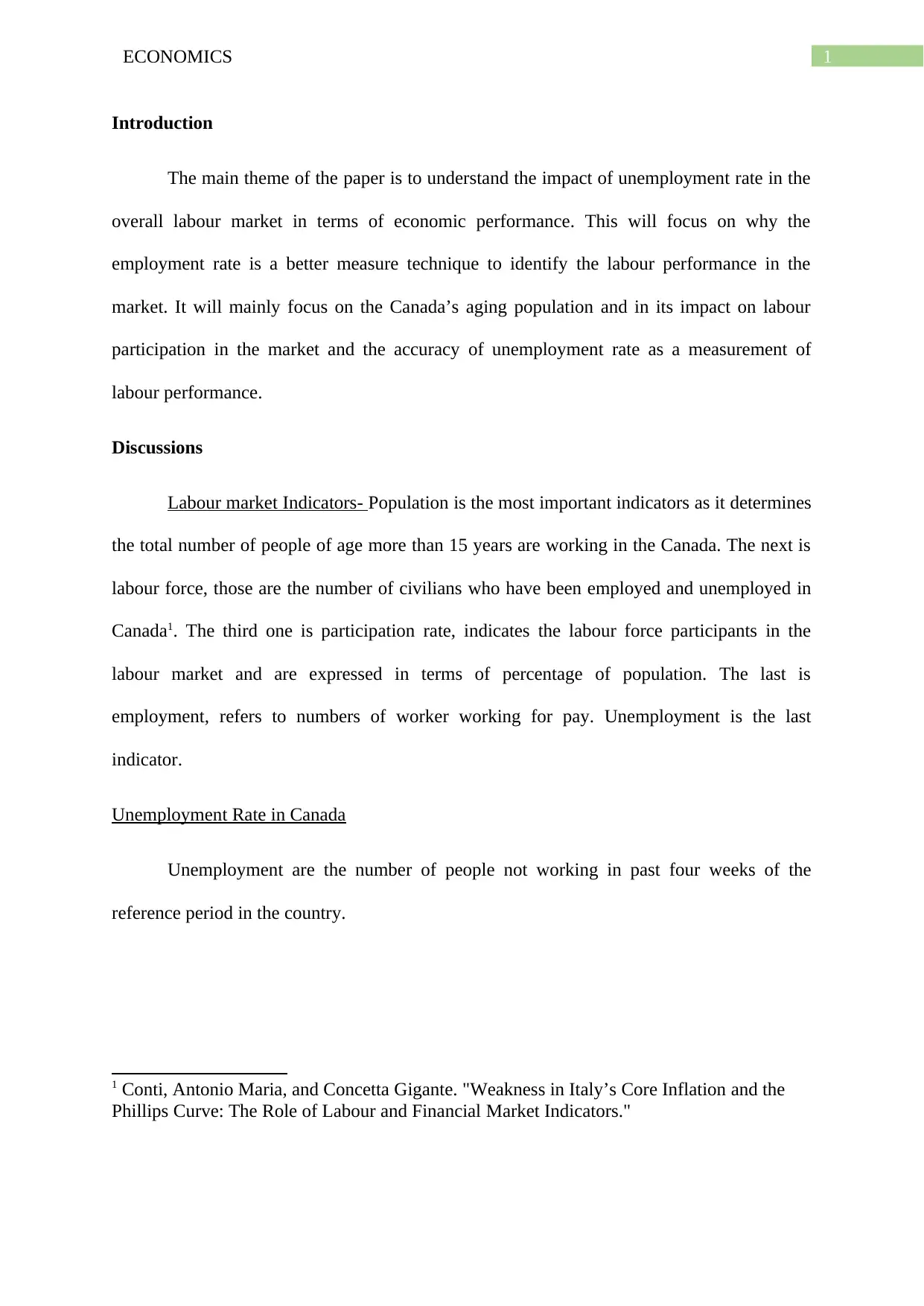
1ECONOMICS
Introduction
The main theme of the paper is to understand the impact of unemployment rate in the
overall labour market in terms of economic performance. This will focus on why the
employment rate is a better measure technique to identify the labour performance in the
market. It will mainly focus on the Canada’s aging population and in its impact on labour
participation in the market and the accuracy of unemployment rate as a measurement of
labour performance.
Discussions
Labour market Indicators- Population is the most important indicators as it determines
the total number of people of age more than 15 years are working in the Canada. The next is
labour force, those are the number of civilians who have been employed and unemployed in
Canada1. The third one is participation rate, indicates the labour force participants in the
labour market and are expressed in terms of percentage of population. The last is
employment, refers to numbers of worker working for pay. Unemployment is the last
indicator.
Unemployment Rate in Canada
Unemployment are the number of people not working in past four weeks of the
reference period in the country.
1 Conti, Antonio Maria, and Concetta Gigante. "Weakness in Italy’s Core Inflation and the
Phillips Curve: The Role of Labour and Financial Market Indicators."
Introduction
The main theme of the paper is to understand the impact of unemployment rate in the
overall labour market in terms of economic performance. This will focus on why the
employment rate is a better measure technique to identify the labour performance in the
market. It will mainly focus on the Canada’s aging population and in its impact on labour
participation in the market and the accuracy of unemployment rate as a measurement of
labour performance.
Discussions
Labour market Indicators- Population is the most important indicators as it determines
the total number of people of age more than 15 years are working in the Canada. The next is
labour force, those are the number of civilians who have been employed and unemployed in
Canada1. The third one is participation rate, indicates the labour force participants in the
labour market and are expressed in terms of percentage of population. The last is
employment, refers to numbers of worker working for pay. Unemployment is the last
indicator.
Unemployment Rate in Canada
Unemployment are the number of people not working in past four weeks of the
reference period in the country.
1 Conti, Antonio Maria, and Concetta Gigante. "Weakness in Italy’s Core Inflation and the
Phillips Curve: The Role of Labour and Financial Market Indicators."
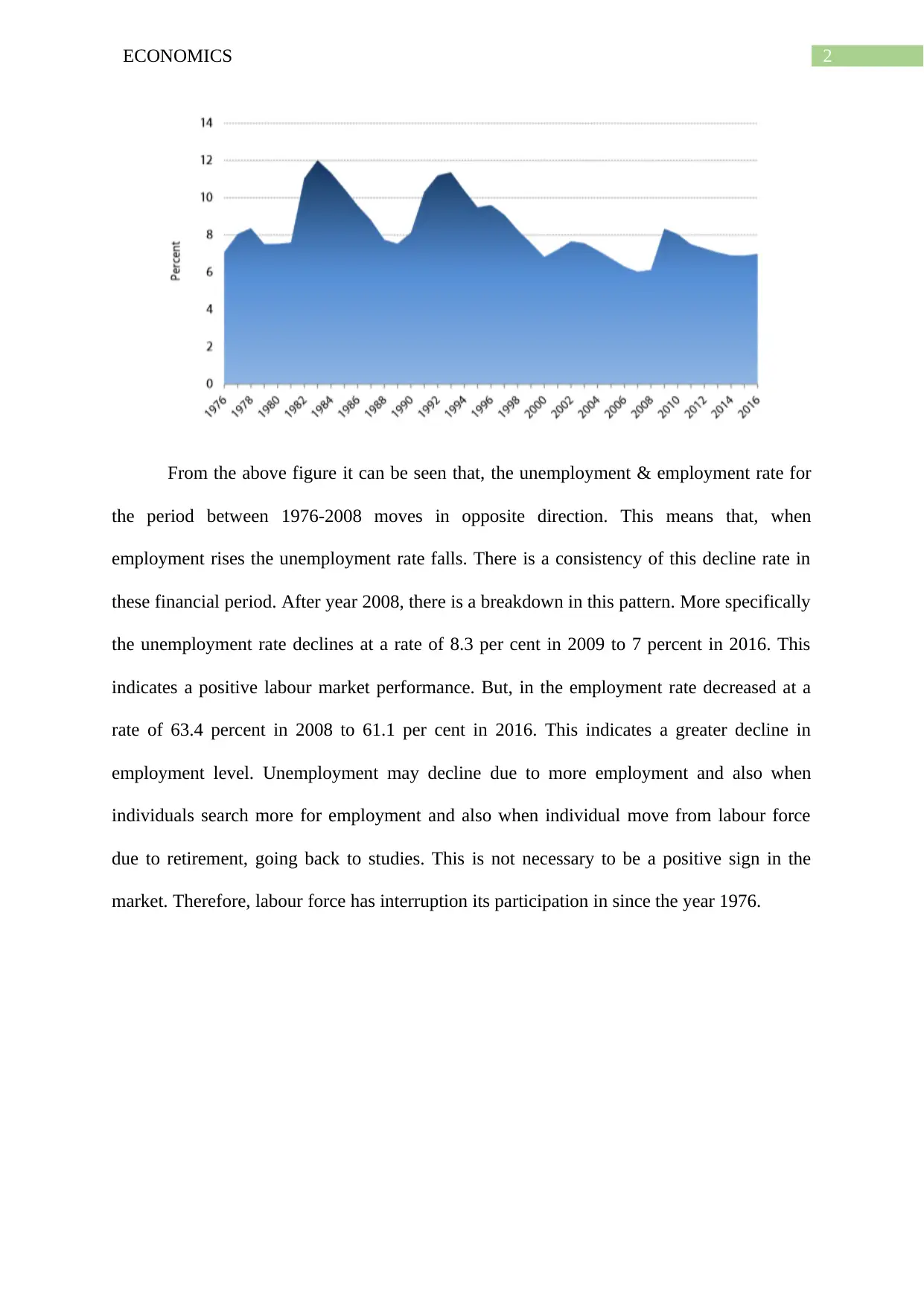
2ECONOMICS
From the above figure it can be seen that, the unemployment & employment rate for
the period between 1976-2008 moves in opposite direction. This means that, when
employment rises the unemployment rate falls. There is a consistency of this decline rate in
these financial period. After year 2008, there is a breakdown in this pattern. More specifically
the unemployment rate declines at a rate of 8.3 per cent in 2009 to 7 percent in 2016. This
indicates a positive labour market performance. But, in the employment rate decreased at a
rate of 63.4 percent in 2008 to 61.1 per cent in 2016. This indicates a greater decline in
employment level. Unemployment may decline due to more employment and also when
individuals search more for employment and also when individual move from labour force
due to retirement, going back to studies. This is not necessary to be a positive sign in the
market. Therefore, labour force has interruption its participation in since the year 1976.
From the above figure it can be seen that, the unemployment & employment rate for
the period between 1976-2008 moves in opposite direction. This means that, when
employment rises the unemployment rate falls. There is a consistency of this decline rate in
these financial period. After year 2008, there is a breakdown in this pattern. More specifically
the unemployment rate declines at a rate of 8.3 per cent in 2009 to 7 percent in 2016. This
indicates a positive labour market performance. But, in the employment rate decreased at a
rate of 63.4 percent in 2008 to 61.1 per cent in 2016. This indicates a greater decline in
employment level. Unemployment may decline due to more employment and also when
individuals search more for employment and also when individual move from labour force
due to retirement, going back to studies. This is not necessary to be a positive sign in the
market. Therefore, labour force has interruption its participation in since the year 1976.
⊘ This is a preview!⊘
Do you want full access?
Subscribe today to unlock all pages.

Trusted by 1+ million students worldwide
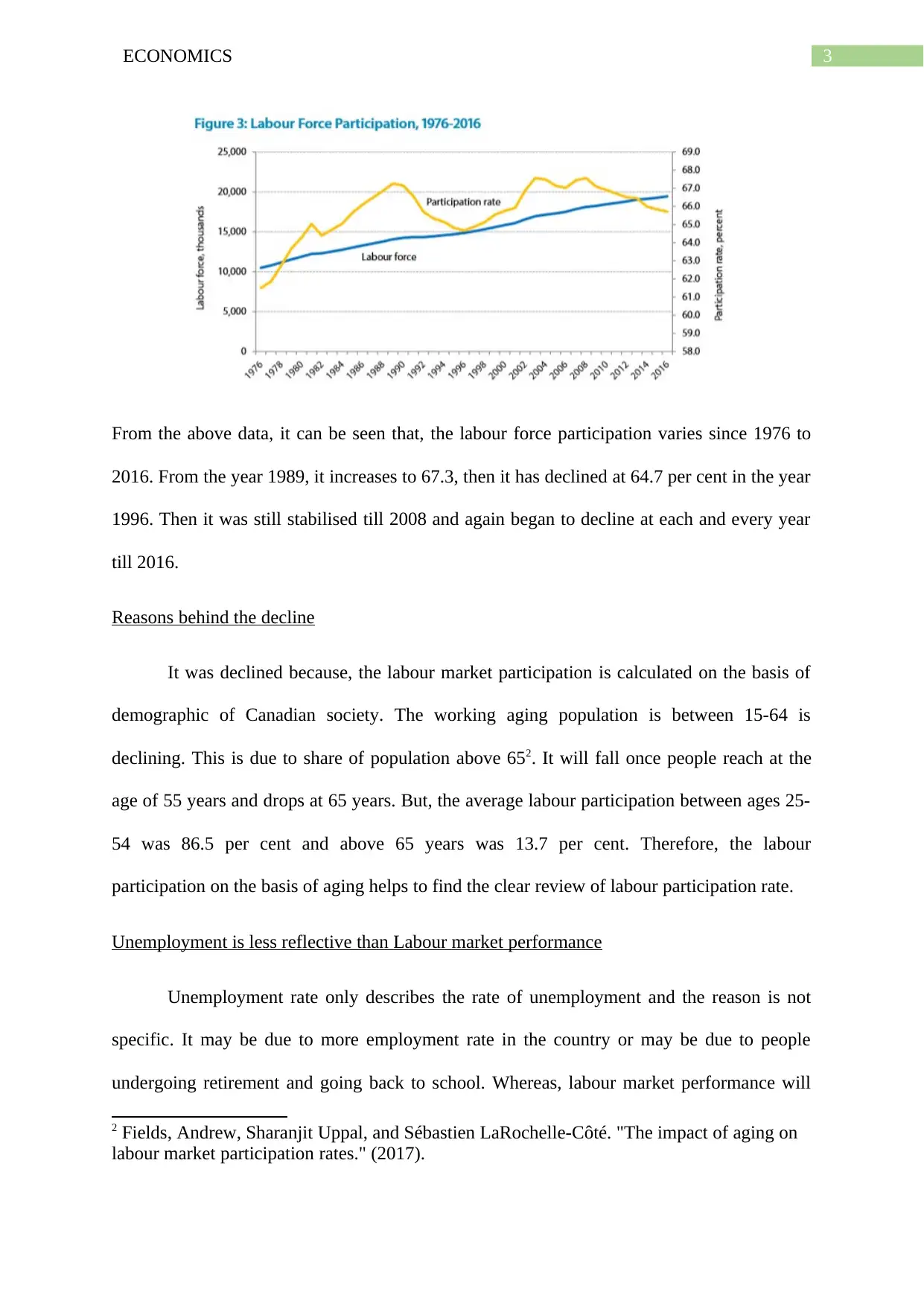
3ECONOMICS
From the above data, it can be seen that, the labour force participation varies since 1976 to
2016. From the year 1989, it increases to 67.3, then it has declined at 64.7 per cent in the year
1996. Then it was still stabilised till 2008 and again began to decline at each and every year
till 2016.
Reasons behind the decline
It was declined because, the labour market participation is calculated on the basis of
demographic of Canadian society. The working aging population is between 15-64 is
declining. This is due to share of population above 652. It will fall once people reach at the
age of 55 years and drops at 65 years. But, the average labour participation between ages 25-
54 was 86.5 per cent and above 65 years was 13.7 per cent. Therefore, the labour
participation on the basis of aging helps to find the clear review of labour participation rate.
Unemployment is less reflective than Labour market performance
Unemployment rate only describes the rate of unemployment and the reason is not
specific. It may be due to more employment rate in the country or may be due to people
undergoing retirement and going back to school. Whereas, labour market performance will
2 Fields, Andrew, Sharanjit Uppal, and Sébastien LaRochelle-Côté. "The impact of aging on
labour market participation rates." (2017).
From the above data, it can be seen that, the labour force participation varies since 1976 to
2016. From the year 1989, it increases to 67.3, then it has declined at 64.7 per cent in the year
1996. Then it was still stabilised till 2008 and again began to decline at each and every year
till 2016.
Reasons behind the decline
It was declined because, the labour market participation is calculated on the basis of
demographic of Canadian society. The working aging population is between 15-64 is
declining. This is due to share of population above 652. It will fall once people reach at the
age of 55 years and drops at 65 years. But, the average labour participation between ages 25-
54 was 86.5 per cent and above 65 years was 13.7 per cent. Therefore, the labour
participation on the basis of aging helps to find the clear review of labour participation rate.
Unemployment is less reflective than Labour market performance
Unemployment rate only describes the rate of unemployment and the reason is not
specific. It may be due to more employment rate in the country or may be due to people
undergoing retirement and going back to school. Whereas, labour market performance will
2 Fields, Andrew, Sharanjit Uppal, and Sébastien LaRochelle-Côté. "The impact of aging on
labour market participation rates." (2017).
Paraphrase This Document
Need a fresh take? Get an instant paraphrase of this document with our AI Paraphraser
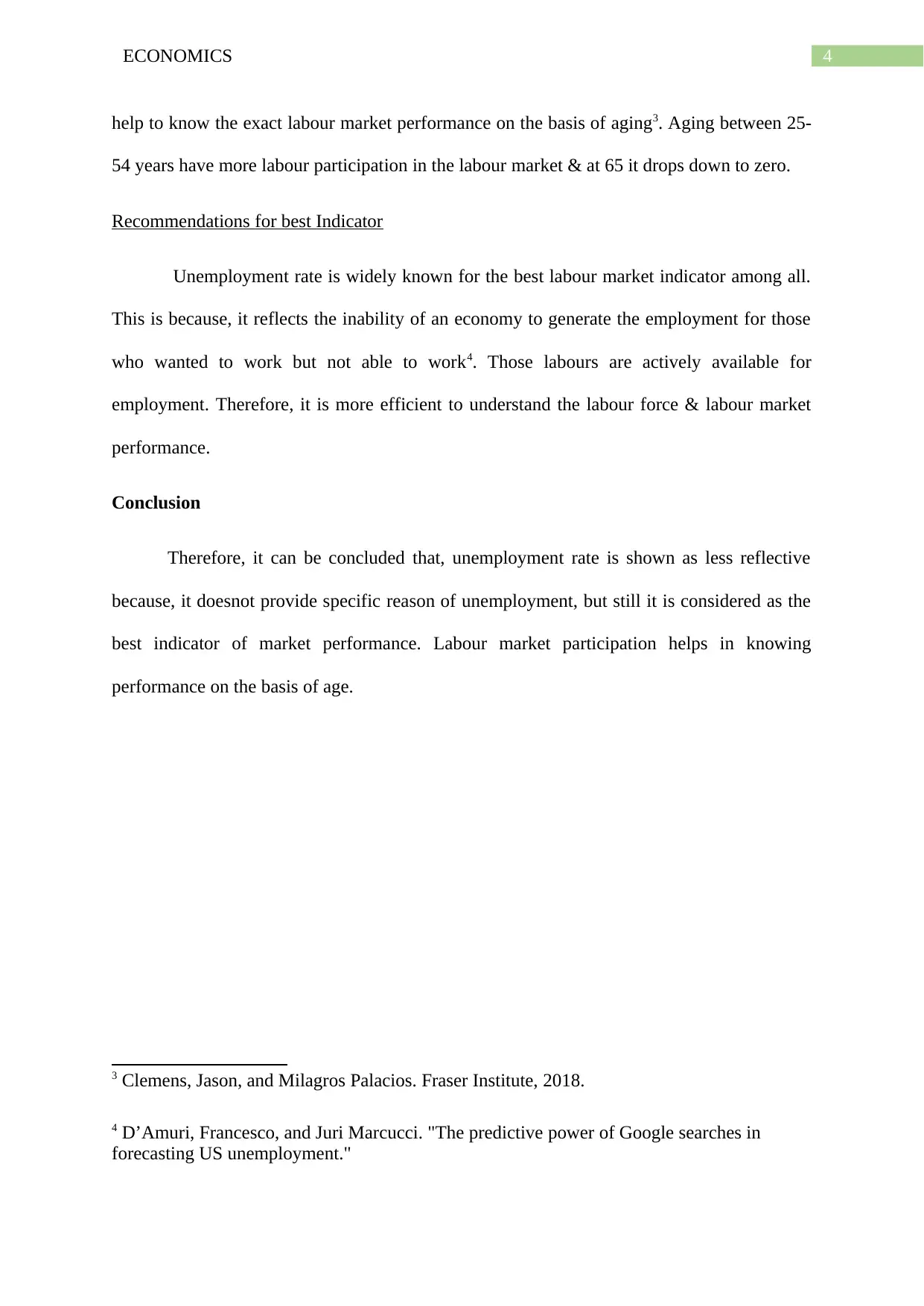
4ECONOMICS
help to know the exact labour market performance on the basis of aging3. Aging between 25-
54 years have more labour participation in the labour market & at 65 it drops down to zero.
Recommendations for best Indicator
Unemployment rate is widely known for the best labour market indicator among all.
This is because, it reflects the inability of an economy to generate the employment for those
who wanted to work but not able to work4. Those labours are actively available for
employment. Therefore, it is more efficient to understand the labour force & labour market
performance.
Conclusion
Therefore, it can be concluded that, unemployment rate is shown as less reflective
because, it doesnot provide specific reason of unemployment, but still it is considered as the
best indicator of market performance. Labour market participation helps in knowing
performance on the basis of age.
3 Clemens, Jason, and Milagros Palacios. Fraser Institute, 2018.
4 D’Amuri, Francesco, and Juri Marcucci. "The predictive power of Google searches in
forecasting US unemployment."
help to know the exact labour market performance on the basis of aging3. Aging between 25-
54 years have more labour participation in the labour market & at 65 it drops down to zero.
Recommendations for best Indicator
Unemployment rate is widely known for the best labour market indicator among all.
This is because, it reflects the inability of an economy to generate the employment for those
who wanted to work but not able to work4. Those labours are actively available for
employment. Therefore, it is more efficient to understand the labour force & labour market
performance.
Conclusion
Therefore, it can be concluded that, unemployment rate is shown as less reflective
because, it doesnot provide specific reason of unemployment, but still it is considered as the
best indicator of market performance. Labour market participation helps in knowing
performance on the basis of age.
3 Clemens, Jason, and Milagros Palacios. Fraser Institute, 2018.
4 D’Amuri, Francesco, and Juri Marcucci. "The predictive power of Google searches in
forecasting US unemployment."
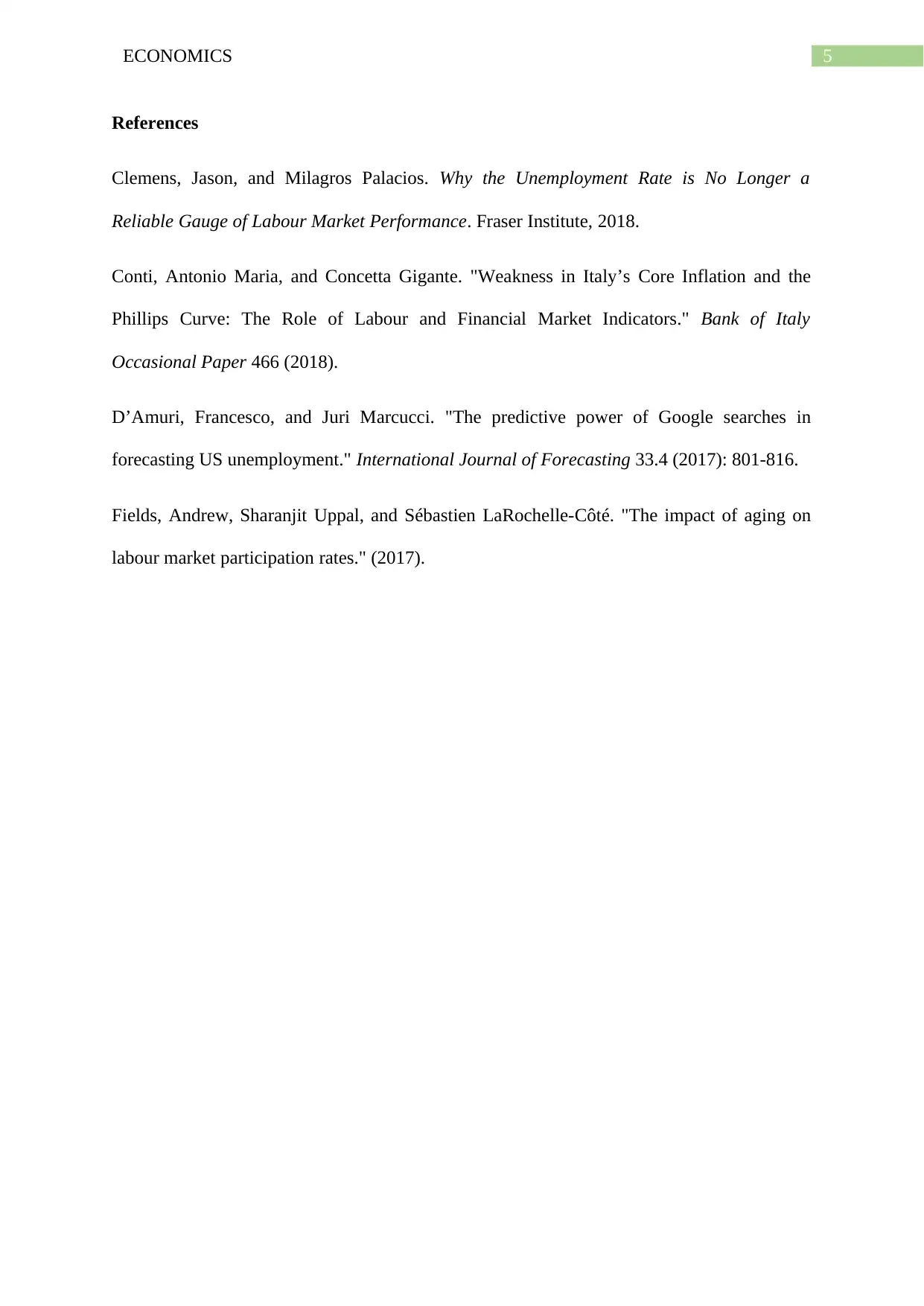
5ECONOMICS
References
Clemens, Jason, and Milagros Palacios. Why the Unemployment Rate is No Longer a
Reliable Gauge of Labour Market Performance. Fraser Institute, 2018.
Conti, Antonio Maria, and Concetta Gigante. "Weakness in Italy’s Core Inflation and the
Phillips Curve: The Role of Labour and Financial Market Indicators." Bank of Italy
Occasional Paper 466 (2018).
D’Amuri, Francesco, and Juri Marcucci. "The predictive power of Google searches in
forecasting US unemployment." International Journal of Forecasting 33.4 (2017): 801-816.
Fields, Andrew, Sharanjit Uppal, and Sébastien LaRochelle-Côté. "The impact of aging on
labour market participation rates." (2017).
References
Clemens, Jason, and Milagros Palacios. Why the Unemployment Rate is No Longer a
Reliable Gauge of Labour Market Performance. Fraser Institute, 2018.
Conti, Antonio Maria, and Concetta Gigante. "Weakness in Italy’s Core Inflation and the
Phillips Curve: The Role of Labour and Financial Market Indicators." Bank of Italy
Occasional Paper 466 (2018).
D’Amuri, Francesco, and Juri Marcucci. "The predictive power of Google searches in
forecasting US unemployment." International Journal of Forecasting 33.4 (2017): 801-816.
Fields, Andrew, Sharanjit Uppal, and Sébastien LaRochelle-Côté. "The impact of aging on
labour market participation rates." (2017).
⊘ This is a preview!⊘
Do you want full access?
Subscribe today to unlock all pages.

Trusted by 1+ million students worldwide
1 out of 6
Related Documents
Your All-in-One AI-Powered Toolkit for Academic Success.
+13062052269
info@desklib.com
Available 24*7 on WhatsApp / Email
![[object Object]](/_next/static/media/star-bottom.7253800d.svg)
Unlock your academic potential
Copyright © 2020–2025 A2Z Services. All Rights Reserved. Developed and managed by ZUCOL.





